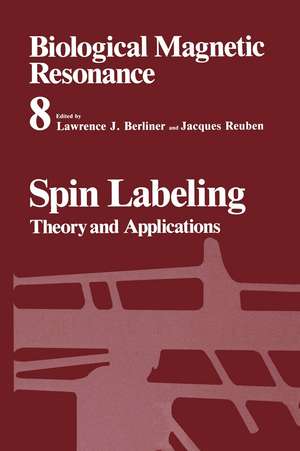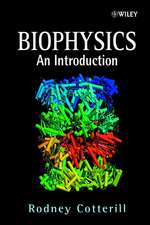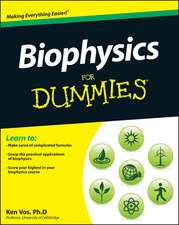Spin Labeling: Theory and Applications: Biological Magnetic Resonance, cartea 8
Editat de Lawrence J. Berliner, Jacques Reubenen Limba Engleză Paperback – 17 sep 2011
Din seria Biological Magnetic Resonance
-
 Preț: 388.72 lei
Preț: 388.72 lei - 18%
 Preț: 951.14 lei
Preț: 951.14 lei - 18%
 Preț: 1225.48 lei
Preț: 1225.48 lei -
 Preț: 391.02 lei
Preț: 391.02 lei - 5%
 Preț: 376.22 lei
Preț: 376.22 lei - 5%
 Preț: 374.20 lei
Preț: 374.20 lei - 18%
 Preț: 958.07 lei
Preț: 958.07 lei - 5%
 Preț: 1416.09 lei
Preț: 1416.09 lei - 5%
 Preț: 1423.22 lei
Preț: 1423.22 lei - 5%
 Preț: 2126.73 lei
Preț: 2126.73 lei - 5%
 Preț: 1444.08 lei
Preț: 1444.08 lei - 5%
 Preț: 1426.71 lei
Preț: 1426.71 lei - 5%
 Preț: 1097.54 lei
Preț: 1097.54 lei - 5%
 Preț: 739.69 lei
Preț: 739.69 lei - 5%
 Preț: 402.11 lei
Preț: 402.11 lei - 5%
 Preț: 2123.06 lei
Preț: 2123.06 lei - 5%
 Preț: 1427.98 lei
Preț: 1427.98 lei - 15%
 Preț: 643.65 lei
Preț: 643.65 lei - 5%
 Preț: 1433.46 lei
Preț: 1433.46 lei - 5%
 Preț: 1412.99 lei
Preț: 1412.99 lei - 5%
 Preț: 1431.45 lei
Preț: 1431.45 lei -
 Preț: 387.96 lei
Preț: 387.96 lei - 18%
 Preț: 1689.69 lei
Preț: 1689.69 lei - 5%
 Preț: 720.84 lei
Preț: 720.84 lei - 5%
 Preț: 717.20 lei
Preț: 717.20 lei - 18%
 Preț: 891.65 lei
Preț: 891.65 lei - 18%
 Preț: 942.44 lei
Preț: 942.44 lei - 15%
 Preț: 642.83 lei
Preț: 642.83 lei
Preț: 657.39 lei
Preț vechi: 773.41 lei
-15% Nou
Puncte Express: 986
Preț estimativ în valută:
125.79€ • 131.69$ • 104.08£
125.79€ • 131.69$ • 104.08£
Carte tipărită la comandă
Livrare economică 07-21 aprilie
Preluare comenzi: 021 569.72.76
Specificații
ISBN-13: 9781461280606
ISBN-10: 1461280605
Pagini: 676
Ilustrații: 670 p.
Dimensiuni: 152 x 229 x 35 mm
Greutate: 0.89 kg
Ediția:Softcover reprint of the original 1st ed. 1989
Editura: Springer Us
Colecția Springer
Seria Biological Magnetic Resonance
Locul publicării:New York, NY, United States
ISBN-10: 1461280605
Pagini: 676
Ilustrații: 670 p.
Dimensiuni: 152 x 229 x 35 mm
Greutate: 0.89 kg
Ediția:Softcover reprint of the original 1st ed. 1989
Editura: Springer Us
Colecția Springer
Seria Biological Magnetic Resonance
Locul publicării:New York, NY, United States
Public țintă
ResearchCuprins
1 Calculating Slow Motional Magnetic Resonance Spectra: A User’s Guide.- 1. Introduction.- 2. General Theoretical Considerations.- 2.1. Terms Included in the Liouville and Diffusion Superoperators.- 2.2. Definitions of Coordinate Systems.- 2.3. Basis Vectors and Scalar Product in Operator Space.- 2.4. Construction of the Spin Hamiltonian.- 2.5. Matrix Elements of the Liouville Superoperator.- 2.6. Construction and Matrix Elements of the Diffusion Super-operator.- 2.7. Components of the Starting Vector.- 2.8. The High-Field Approximation.- 3. Magnetic Resonance Line Shapes and the Complex Symmetric Lanczos Algorithm.- 3.1. The Real Symmetric Lanczos Algorithm.- 3.2. The Complex Symmetric Lanczos Algorithm.- 3.3. The Real Symmetric Conjugate Gradients Algorithm.- 3.4. The Complex Symmetric Conjugate Gradients Algorithm.- 3.5. The Continued-Fraction Representation of the Spectral Function.- 3.6. Convergence of the Sequence of Approximate Spectral Functions.- 4. Computational Considerations.- 4.1. Naming Conventions for Files.- 4.2. Array Dimensions and Common Blocks.- 4.3. The Parameter Input Program: LBLL.- 4.4. Spectral Calculations: EPRLL and EPRCGL.- 4.5. Calculation of the Spectral Function: TDLL.- 4.6. “Field Sweep” Conjugate-Gradients Calculations: EPRBL and TNLL.- 4.7. Auxiliary Programs: D200, STVT, MATLST, and VECLST.- 4.8. Porting Programs to Other Machines.- 5. Example Calculations.- 5.1. Model Calculations and General Strategy.- 5.2. Examples from the Literature.- Appendix: Parameters for Example Calculations.- References.- 2 Inhomogeneously Broadened Spin-Label Spectra.- 1. Introduction.- 2. Experimental Determination of Hyperfine Coupling Constants.- 2.1. NMR and ENDOR.- 2.2. ESR Simulation.- 2.3. Solvent Dependence of Hyperfine Coupling Constants.- 3.Gaussian Contributions to Spin-Label Line Shapes.- Example 1.- 4. The Voight Approximation and a One-Parameter Description of Line Shapes.- Example 2.- 5. Line-Shape Comparisons.- 5.1. Unresolved Hyperfine Multiplets.- 5.2. A Universal Nitroxide.- 5.3. Gaussian-Lorentzian Sum Approximations.- 6. Correcting the Linewidth of an Inhomogeneously Broadened Line.- 6.1. Known Hyperfine Coupling Constants.- Example 3. Solvent Dependence of ?HppG.- Example 4. Dependence of ?HppGon Spin-Label Alignment in an Ordered Fluid.- 6.2. Unknown Hyperfine Coupling Constants.- Example 5.- 6.3. Additional Broadening Method.- 7. The Relationship of Linewidth Ratios to Measured Line-Height Ratios.- 7.1. Rotational Correlation Times.- Example 6.- 7.2. Linewidth Ratios Over a Broader Range.- Example 7. Measuring Oxygen Concentrations Using Unresolved Spin-Label Spectra.- 8. Accurate Estimate of Relative Doubly-Integrated Spectral Intensities.- Example 8. A Hypothetical Spin-Label Partitioning Experiment.- 9. Determining Spin-Exchange Frequencies of Spin Labels in Liquids of Low Viscosity.- 10. Deuterated Spin Labels.- 10.1. Gaussian Linewidth of Deuterated Spin Labels.- 10.2. Proton Contamination of a Deuterated Spin Label.- Example 9.- Example 10.- 11. Conclusions.- References.- 3 Saturation Transfer Spectroscopy of Spin Labels: Techniques and Interpretation of Spectra.- 1. Introduction.- 2. Basic Principles of Saturation Transfer ESR.- 2.1. The Spin Hamiltonian.- 2.2. ESR Spectra of Immobilized Spin Labels.- 2.3. The Bloch Equations.- 2.4. Qualitative Explanation of ST-ESR.- 2.5. Spectral Displays of ST-ESR.- 2.6. Analysis of ST-ESR Spectra.- 3. Measurements of Saturation Transfer ESR Spectra.- 3.1. The Resonant Cavity.- 3.2. Effect of Sample on Cavity Properties.- 3.3. Phase-SensitiveDetection.- 3.4. Calibration Procedures.- 3.5. Standard Conditions for ST-ESR Spectroscopy.- 4. Analysis of Saturation Transfer ESR Spectra.- 4.1. Isotropic Motion.- 4.2. Anisotropic Motion.- 5. Future Developments.- References.- 4 Nitrogen-15 and Deuterium Substituted Spin Labels for Studies of Very Slow Rotational Motion.- 1. Introduction.- 2. Overview of Rotational Diffusion Models.- 2.1. Definition of Rotational Correlation Times.- 2.2. Isotropic Rotational Diffusion.- 2.3. Anisotropic Rotational Diffusion in an Isotropic Medium.- 2.4. Uniaxial Rotational Diffusion in an Anisotropic Medium.- 3. Sensitivity of cw-ST-EPR Signals to Rotational Motion.- 3.1. Choice of Signal.- 3.2. Sensitivity to Motion.- 3.3. The Case of Isotropic Motion and Anisotropic Magnetic Tensors.- 3.4. Effects of Anisotropic Motion and Anisotropic Tensors.- 3.5. Geometric Considerations for Analyzing Anisotropic Motion.- 4. Analysis of cw-ST-EPR Data.- 4.1. Isotropic Model Systems.- 4.2. Anisotropic Model Systems.- 4.3. Anisotropic Motional Modeling by Computer Simulations.- 4.4. Overview of Theory for Computation of ST-EPR Spectra.- 5. Studies of Isotropic Motion with Nitrogen-15 Spin Labels.- 5.1. V1EPR Signals as a Function of ?r.- 5.2. Dependence of the V?2Signal on ?r.- 6. Effects of Anisotropic Rotational Diffusion on V?2Spectra.- 6.1. Sensitivity of V?2to Uniaxial Rotation.- 6.2. Effects of Labeling Geometry.- 6.3. Sensitivity of V’2to Anisotropic Rotational Diffusion of Axially Symmetric Ellipsoids in an Isotropic Medium.- 6.4. Relationship between Effective Correlation Times and Anisotropic Motion.- 7. Optimization of Sensitivity of V’2to Motion.- 7.1. Altering Sensitivity to Motion by Selection of v0.- 7.2. Altering Sensitivity to Motion by Selection of vm.- 8. Analysisof Overlapping Motional Species.- 8.1. One Fast and One Slow Motional Component.- 8.2. Two or More Slow Motional Components.- 9. Computer Modeling of Nitrogen-14 V’2Signals.- 9.1. Isotropic Motion Simulations.- 9.2. Anisotropic Motion Simulations.- 9.3. Signal-to-Noise Ratio and Motional Sensitivity of Nitrogen-15 versus Nitrogen-14 Spin Labels.- 10. Saturation Recovery EPR Studies with Nitrogen-15 Spin Labels.- 10.1. Overview of the Experiment.- 10.2. Spectrometer Variables.- 10.3. Strategies for Extraction of Motional Information.- 10.4. Theory of Saturation Recovery.- 10.5. Pseudosecular Terms.- 10.6. Isotropic Brownian Motion—Secular Terms Only.- 10.7. Results of Calculations of SR Curves for Isotropic Motion.- 10.8. Results of Calculations of SR Curves for Nonaxial Tensors.- 10.9. Effects of Pseudosecular Terms.- 10.10. Pseudosecular Terms using Nitrogen-14.- 10.11. Population Analysis: An Estimate of Amplitudes.- 11. Conclusions.- References.- 5 Experimental Methods in Spin-Label Spectral Analysis.- 1. Introduction.- 2. Inhomogeneous Broadening.- 3. Fast Rotational Motion.- 4. Slow Rotational Motion.- 5. Anisotropic Rotation: Lipids/Membranes.- 6. Spin-Spin Interactions and Lateral Diffusion.- 6.1. Spin-Spin Exchange.- 6.2. Translational Diffusion and Bimolecular Collision Rate.- 6.3. Dipolar Spin-Spin Broadening.- 6.4. Separation of Exchange and Dipole-Dipole Interactions.- 7. Lipid-Protein Interactions.- 7.1. Spectral Subtraction/Addition.- 7.2. Measurements at 35 GHz.- 7.3. Analysis of Lipid-Protein Association.- 7.4. Two-Site Exchange Simulations.- 8. Saturation Transfer ESR.- 8.1. Power and Modulation Calibration and the Effects of Sample Shape, Size, and Dielectric Absorption.- 8.2. Anisotropic Rotation.- 8.3. Integral Method: Multicomponent Spectra.-8.4. Dispersion Spectra: Difference Spectroscopy.- References.- 6 Electron-Electron Double Resonance.- 1. Introduction.- 1.1. Definitions and Background.- 1.2. Historical Overview.- 2. Rate Equations.- 3. Spin-Label Relaximetry.- 4. Apparatus.- 5. Applications.- 5.1. Lateral Diffusion in Membranes.- 5.2. Studies Utilizing 14N: 15N Spin-Label Pairs.- 5.3. ELDOR in Cells.- 5.4. Comparison with Spin-Exchange Line Broadening.- 5.5. Further Application of 14N: 15N Methodology.- 6. Future Opportunities.- References.- 7 Resolved Electron-Electron Spin-Spin Splittings in EPR Spectra.- 1. The Scope of Electron Spin-Spin Interactions.- 2. The Nature of Electron Spin-Spin Interactions.- 2.1. Dipolar Interaction.- 2.2. Exchange Interaction.- 2.3. Hamiltonian for Spin-Spin Interaction.- 2.4. Computational Approaches.- 3. Analogies between Nuclear-Nuclear, Electron-Nuclear, and Electron-Electron Spin-Spin Interactions and Long-Range Electron Transfer.- 4. Spin-1/2-Spin-1/2 Interaction.- 4.1. Spin-Spin Splitting.- 4.2. Half-Field Transitions.- 4.3. Geometrical Information.- 5. Spin 1-Spin 1/2.- 6. Spin 3/2-Spin 1/2.- 7. Spin 5/2-Spin 1/2.- 7.1. Mn(II) Interacting with S= 1/2.- 7.2. High-Spin Fe(III) Interacting with S= 1/2.- 8. Spin 7/2-Spin 1/2.- 9. Chemical Properties Revealed via Spin-Spin Interactions.- 9.1. Kinetics of Ligand Exchange for Cu(II) i..- 9.2. Coordination Equilibria.- 9.3. Weak Orbital Overlaps.- 10. Spin-Spin Interactions in Biological Systems.- 10.1. Cobalt(II) - Radical Interaction.- 10.2. Mo(V) Interaction with Fe/S Cluster.- 10.3. Iron-Nitroxyl Interaction.- 10.4. Nitroxyl-Nitroxyl Interaction.- 11. Exchange Interaction through Multiatom Linkages.- 12. Quantitative EPR Measurements.- 13. Summary and Prognosis.- References.- 8 Spin-Label Oximetry.- 1. Introduction.- 2. Physics.- 2.1. Bimolecular Collisions.- 2.2. Magnetic Interactions.- 2.3. The Absolute T1Method.- 2.4. The Absolute T2Method.- 3. Experimental Methods.- 3.1. TPX Gas-Exchange Sample Cell.- 3.2. T1Sensitive Methods.- 3.3. T2(Linewidth-Sensitive) Methods.- 4. Applications.- 5. Future Opportunities.- References.- 9 Chemistry of Spin-Labeled Amino Acids and Peptides: Some New Mono- and Bifunctionalized Nitroxide Free Radicals.- 1. Introduction.- 2. Spin Labeling of Amino Acids and Peptides.- 2.1. Reagents for Labeling at the Amino Terminal.- 2.2. C-Terminal Spin-Labeled Amino Acids and Peptides.- 2.3. Amino Acids and Peptides Labeled in the Side Chain.- 3. Nitroxide Amino Acids.- 3.1. Imidazolinyl Nitroxide Amino Acids.- 3.2. Pyrrolidine Nitroxide Amino Acids.- 3.3. Pyrrolinyl Nitroxide Amino Acids.- 3.4. Piperidinyl Nitroxide Amino Acids.- 4. New Mono- and Bifunctionalized Spin Labels.- 4.1. Reactions with 3-Functionalized-3-Pyrroline-l-Oxyl Derivatives.- 4.2. Cross-Linking Spin-Label Reagents.- 4.3. Spin-Labeled Pyrrolidine-1-Oxyl Fatty Acids.- 5. Experimental Procedures for Preparation of Some Pyrroline and Pyrrolidine Nitroxide Spin Labels.- References.- 10 Nitroxide Radical Adducts in Biology: Chemistry, Applications, and Pitfalls.- 1. Introduction.- 2. Halogenated Compounds.- 2.1. Carbon Tetrachloride.- 2.2. Halothane.- 2.3. Others.- 3. Lipid Peroxidation.- 3.1. Linoleic Acid.- 3.2. Methyl Linoleate.- 3.3. Arachidonic Acid.- 3.4. Lipid Peroxyl and Alkoxy Radicals.- 4. Hemoprotein-Organic Hydroperoxides.- 5. Sulfur-Centered Radicals.- 5.1. Sulfur Dioxide, Bisulfite, Sulfite, and Sulfate.- 5.2. Thiols.- 6. Pyridinyl Radicals.- 7. Hydrazines.- 8. Oxygen-Centered Radicals.- 9. Aldehydes.- 9.1. Glyceraldehyde and Other Monosaccharides.- 9.2. Malonaldehyde and Acetylacetone.- 10. Lignin Model Dimers.- 11. 3-Methylindole.- 12. Indole Acetic Acid.- 13. Ethanol.- 14. Tryptophan.- 15. Nitrobenzyl Chlorides.- 16. Azide and Cyanide.- 17. Styrene.- 18. Spin Traps as Enzyme Inhibitors.- 19. Spin Traps as Enzyme Substrates.- 20. In VivoSpin Trapping and Spin Trapping in Cells.- 20.1. Spin Trapping in Cells.- 20.2. Site-Directed Spin Traps.- 20.3. In VivoSpin Trapping.- 21. Spin Adduct Identification.- 21.1. Isotope Methods.- 21.2. Isolation and Identification by HPLC, GC, and MS.- 22. Spin Adduct Imposters.- 23. Summary.- References.- 11 Advantages of 15N and Deuterium Spin Probes for Biomedical Electron Paramagnetic Resonance Investigations.- 1. Introduction.- 2. Maleimide Spin Label (DMSL or 15N,DMSL): A Covalent Ligand for Sulfhydryl Groups of Proteins.- 2.1. Advantages of Deuterated Maleimide Spin Label (DMSL) for Studies of Proteins.- 2.2. Advantages of Doubly Substituted 15N,Deuterated Maleimide Spin Label (15N,DMSL).- 2.3. Advantages of 15N,Deuterated Maleimide Spin Label (15N,DMSL) for Studies of Soluble and Membrane-Bound Enzymes.- 2.4. Future Applications.- 3. Coenzyme Spin Labels: Studies on Coenzyme Binding to Enzymes and Catalytic Mechanisms.- 3.1. Comparison of Spin-Labeled Maleimide Inhibitors (DMSL and 15N,DMSL) and Coenzyme Analogs (SL-NAD+) for EPR.- Studies of Enzymes.- 3.2. The Evaluation of Binding of Isotopically Substituted N6-SL- NAD+or C8-SL-NAD+Using Lactic Dehydrogenase.- 3.3. Glyceraldehyde-3-phosphate Dehydrogenase (GAPDH) and SL-NAD+Binding with Unusual Electron-Electron Dipolar Interactions (Splitting of Peaks).- 3.4. Interactions of N6-(D17M)SL-NAD+with GAPDH Bound to Band-3 Protein of Erythrocyte Membranes.- 3.5. Binding of Deuterated and 15N,Deuterated-SL-NADH Analogs to ß-Hydroxybutyrate Dehydrogenase(BDH).- 3.6. Binding of Spin-Labeled Adenine Nucleotides to Dehydrogenases and F1ATPase.- 3.7. Future Applications.- 4. Advantages of 15N, and 15N,Deuterated Stearic Acid and Cholestane Spin Labels for Evaluation of Motion of Lipids in Membranes.- 4.1. Improved Spectral Sensitivity of Rapidly Tumbling 15N and 15N,Deuterium Substituted Stearic Acid and Cholestane Analogs.- 4.2. Advantages of 15N and 15N,Deuterated Stearic Acid Spin Labels for Studies on Binding to Proteins.- 4.3. Improved Spectral Analysis of Lipid Motion in Erythrocyte (RBC) Membranes with 15N-5-NS and (15N,D12)-5-NS.- 4.4. Investigation of Erythrocyte Abnormalities Using 15N-5-NS.- 4.5. Studies of Collision Frequency and Vertical Fluctuations of 14N and 15N Spin-Labeled Pairs of Fatty Acids in Membranes Using ELDOR Spectroscopy.- 4.6. Future Applications.- References.- 12 Magnetic Resonance Study of the Combining Site Structure of a Monoclonal Anti-Spin-Label Antibody.- 1. Introduction.- 2. Amino Acid Composition of the Antibody Combining Site.- 3. Distance Determination.- 4. Contributions of Heavy and Light Chains to the Combining Site.- 5. Determination of Short Distances.- 6. Conclusion.- References.- Appendix Approaches to the Chemical Synthesis of l5N and Deuterium Substituted Spin Labels.- 1. Introduction.- 2. Synthesis of Deuterated and 15N,Deuterated Maleimide Spin Labels (DMSL and 15N-DMSL).- 3. Synthesis of Deuterated and 15N,Deuterated Adenine Nucleotide Derivatives.- 3.1. Synthesis of N6-(D17)SL-AMP (10a) or N6-(15N,D17)SL-AMP (10b).- 3.2. Synthesis of C8-(D17)SL-AMP (12a) or C8(15N,D17)SL-AMP (12b).- 3.3. Synthesis of N6-SL-ATP (14).- 3.4. Synthesis of C8-(15N,D17)SL-ATP.- 3.5. Synthesis of N6- or C8-SL-Analogs of AMPPCP or AMPPNP.- 3.6. Synthesis of a Mixture of 2?- and3?-(15N,D13)SL-ATP (17).- 3.7. Synthesis of N6-SL-ADP and C8-SL-ADP.- 3.8. Synthesis of N6-(D17)SL-NAD+ (18a) and N6-(15N,D17)SL- NAD+(18b).- 3.9. Synthesis of C8-(D17)SL-NAD+and C8-(15N,D17)SL-NAD+.- 4. Synthesis of 15N and 15N,Deuterated Stearic Acid Spin Labels.- 4.1. Synthesis of 15N-5-Doxylstearic Acid Spin Label (26).- 4.2. Synthesis of 15N-12-Doxylstearic Acid-d41(27).- 5. Conclusions.- References.- of Previous Volumes.
Notă biografică
Dr. Lawrence J. Berliner is currently Professor and Chair of the Department of Chemistry and Biochemistry at the University of Denver after retiring from Ohio State University, where he spent a 32-year career in the area of biological magnetic resonance (EPR and NMR). He is the Series Editor for Biological Magnetic Resonance, which he launched in 1979.











